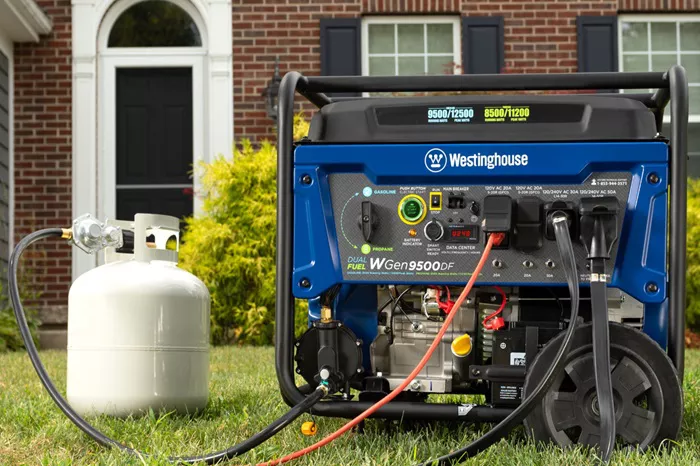Portable generators are essential for providing backup power during outages or supplying electricity in remote locations. Understanding how they work can help you choose the right model and use it safely. In this article, we’ll break down the mechanics, components, and operation of home portable generators in an easy-to-understand way.
Basic Components of a Portable Generator
A portable generator consists of several key parts that work together to produce electricity:
Engine
The engine is the heart of the generator, typically powered by gasoline, propane, or diesel. It converts fuel into mechanical energy, which drives the alternator to produce electricity.
Alternator (Generator Head)
The alternator contains a rotor (moving part) and a stator (stationary part). As the engine spins the rotor inside the stator, it creates an electromagnetic field, generating alternating current (AC) electricity.
Fuel System
The fuel system includes a tank, fuel pump (in some models), and carburetor. It supplies fuel to the engine for combustion.
Voltage Regulator
This component stabilizes the output voltage to ensure a consistent flow of electricity, preventing damage to connected devices.
Cooling & Exhaust System
Generators produce heat, so they need cooling systems (air or liquid) to prevent overheating. The exhaust system vents harmful gases like carbon monoxide away from the unit.
Control Panel
The control panel includes outlets, circuit breakers, and monitoring gauges (voltage, frequency, and runtime). Some models feature electric start buttons, while others use pull-start mechanisms.
Battery (For Electric Start Models)
Battery-powered generators use a rechargeable battery to start the engine with a push button instead of a pull cord.
How a Portable Generator Produces Electricity
Fuel Combustion Powers the Engine
When you start the generator, the engine burns fuel (gasoline, diesel, or propane) in the combustion chamber. This process creates mechanical energy that turns the crankshaft.
The Alternator Converts Mechanical Energy to Electrical Energy
The spinning crankshaft rotates the rotor inside the alternator. As the rotor moves past the stator’s copper coils, it induces an electromagnetic field, generating AC electricity.
Voltage Regulation for Stable Power Output
The voltage regulator adjusts the current to maintain a steady voltage (usually 120V or 240V), ensuring safe operation for connected appliances.
Power Distribution Through Outlets
Electricity flows from the alternator to the control panel, where outlets allow you to plug in devices. Circuit breakers protect against overloads.
Types of Portable Generators
Conventional (Open-Frame) Generators
- Most common and affordable
- Loud operation due to open design
- Best for construction sites or outdoor use
Inverter Generators
- Quieter and more fuel-efficient
- Produce “clean” power (stable voltage) for sensitive electronics
- Compact and lightweight
Dual-Fuel Generators
- Can run on gasoline or propane
- Greater flexibility in fuel choice
- Propane burns cleaner but may provide slightly less power
Safety Considerations When Using a Portable Generator
Proper Ventilation to Prevent Carbon Monoxide Poisoning
- Never run a generator indoors or in an enclosed space
- Place it at least 20 feet away from windows and doors
Grounding the Generator
- Some models require grounding to prevent electric shock
- Follow the manufacturer’s instructions for proper grounding
Avoid Overloading
- Check the generator’s wattage capacity
- Add up the power requirements of connected devices to prevent tripping the breaker
Use Heavy-Duty Extension Cords
- Only use outdoor-rated, grounded extension cords
- Ensure cords are in good condition to prevent fires
Maintenance Tips for Longevity
Regular Oil Changes
- Change oil every 50-100 hours of use (check the manual)
- Use the recommended oil type (e.g., 10W-30)
Fuel Stabilization
- If storing for long periods, add a fuel stabilizer to prevent clogging
- Drain old gasoline before refilling
Air Filter Cleaning/Replacement
- A dirty air filter reduces efficiency
- Clean or replace it periodically
Battery Maintenance (For Electric Start Models)
- Keep the battery charged
- Store in a cool, dry place when not in use
Choosing the Right Portable Generator for Your Home
Determine Your Power Needs
- Calculate the total wattage of essential appliances
- Choose a generator with at least 20% extra capacity
Consider Runtime & Fuel Efficiency
- Larger tanks provide longer runtime but increase weight
- Inverter generators are more fuel-efficient
Noise Levels
Inverter models are quieter (50-60 dB) compared to open-frame generators (70+ dB)
Portability Features
- Wheels and handles make transportation easier
- Lighter models are better for frequent moving
Conclusion
Home portable generators provide a reliable power source during outages or for off-grid use. By understanding how they work—from fuel combustion to electricity generation—you can operate them safely and efficiently. Regular maintenance and proper usage will extend their lifespan, ensuring they’re ready when you need them most. Whether you choose a conventional, inverter, or dual-fuel model, always prioritize safety and follow manufacturer guidelines.
By following this guide, you’ll be well-equipped to select, operate, and maintain a portable generator for your home. Stay powered, stay safe!

